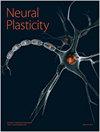Topologic Reorganization of White Matter Connectivity Networks in Early-Blind Adolescents
IF 3.7
4区 医学
Q2 Medicine
引用次数: 0
Abstract
Blindness studies are important models for the comprehension of human brain development and reorganization, after visual deprivation early in life. To investigate the global and local topologic alterations and to identify specific reorganized neural patterns in early-blind adolescents (EBAs), we applied diffusion tensor tractography and graph theory to establish and analyze the white matter connectivity networks in 21 EBAs and 22 age- and sex-matched normal-sighted controls (NSCs). The network profiles were compared between the groups using a linear regression model, and the associations between clinical variables and network profiles were analyzed. Graph theory analysis revealed “small-world” attributes in the structural connection networks of both EBA and NSC cohorts. The EBA cohort exhibited significant lower network density and global and local efficiency, as well as significantly elevated shortest path length, compared to the NSC group. The network efficiencies were markedly reduced in the EBA cohort, with the largest alterations in the default-mode, visual, and limbic areas. Moreover, decreased regional efficiency and increased nodal path length in some visual and default-mode areas were strongly associated with the period of blindness in EBA cohort, suggesting that the function of these areas would gradually weaken in the early-blind brains. Additionally, the differences in hub distribution between the two groups were mainly within the occipital and frontal areas, suggesting that neural reorganization occurred in these brain regions after early visual deprivation during adolescence. This study revealed that the EBA brain structural network undergoes both convergent and divergent topologic reorganizations to circumvent early visual deprivation. Our research will add to the growing knowledge of underlying neural mechanisms that govern brain reorganization and development, under conditions of early visual deprivation.早期失明青少年白质连接网络的拓扑重组
失明研究是理解早期视觉剥夺后人类大脑发育和重组的重要模型。为了研究早期失明青少年(eba)的整体和局部拓扑改变,并识别特定的重组神经模式,我们应用扩散张量神经束成像和图论建立并分析了21名早期失明青少年和22名年龄和性别匹配的正常视力对照(NSCs)的白质连接网络。采用线性回归模型比较两组间的网络概况,并分析临床变量与网络概况之间的关系。图论分析揭示了EBA和NSC群体结构连接网络的“小世界”属性。与NSC组相比,EBA组的网络密度、整体和局部效率显著降低,最短路径长度显著增加。在EBA队列中,网络效率显著降低,默认模式、视觉和边缘区域的变化最大。此外,在EBA队列中,部分视觉和默认模式区域的效率下降和节点路径长度增加与失明时间密切相关,表明这些区域的功能在早期失明的大脑中逐渐减弱。此外,两组之间中枢分布的差异主要集中在枕叶和额叶区域,这表明在青春期早期视觉剥夺后,这些大脑区域发生了神经重组。本研究表明,EBA脑结构网络经历了收敛和发散的拓扑重组,以避免早期视觉剥夺。我们的研究将增加对早期视觉剥夺条件下控制大脑重组和发育的潜在神经机制的不断增长的知识。
本文章由计算机程序翻译,如有差异,请以英文原文为准。
求助全文
约1分钟内获得全文
求助全文
来源期刊

Neural Plasticity
Neuroscience-Neurology
CiteScore
5.70
自引率
0.00%
发文量
0
审稿时长
1 months
期刊介绍:
Neural Plasticity is an international, interdisciplinary journal dedicated to the publication of articles related to all aspects of neural plasticity, with special emphasis on its functional significance as reflected in behavior and in psychopathology. Neural Plasticity publishes research and review articles from the entire range of relevant disciplines, including basic neuroscience, behavioral neuroscience, cognitive neuroscience, biological psychology, and biological psychiatry.
 求助内容:
求助内容: 应助结果提醒方式:
应助结果提醒方式:


